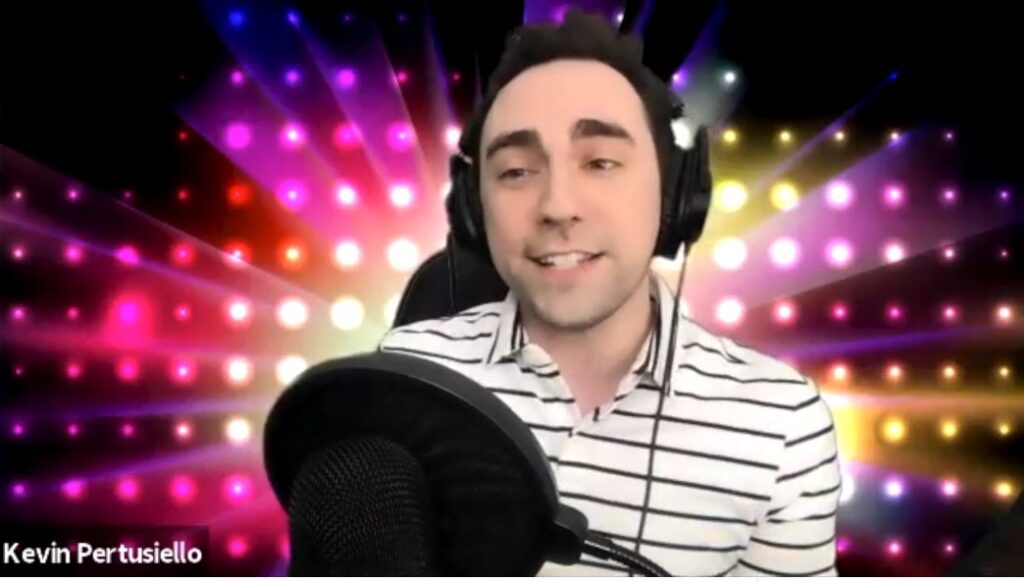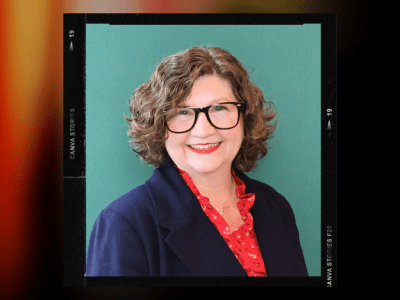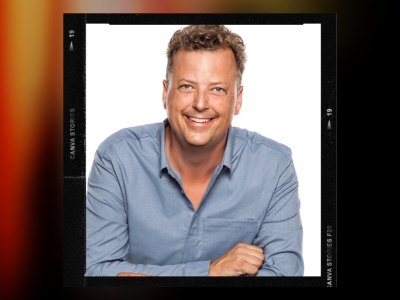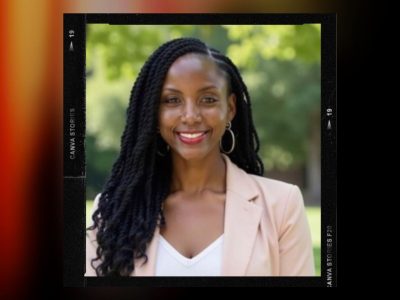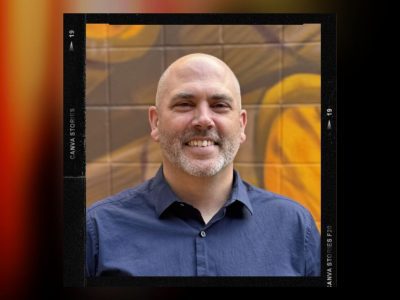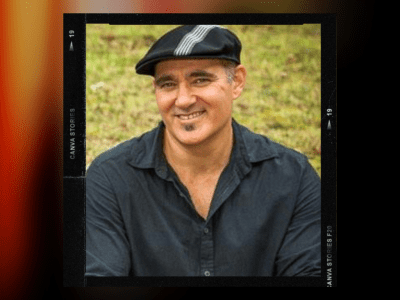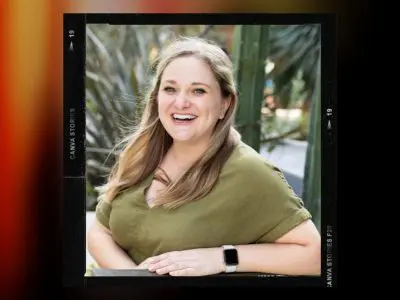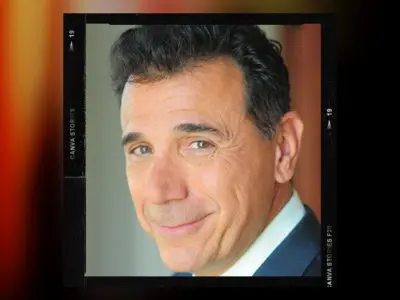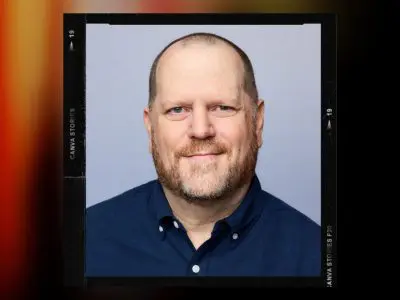Behind the Curtain!
A behind-the-scenes look at TeamBonding
Use the buttons above to listen now.
Transcript - Behind the Curtain!
Rich: The following is a presentation of team bonding, providing more than 100 live virtual or hybrid corporate team building activities for companies around the world. Visit team bonding.com to schedule your event. On this episode of team building saves the world.
Sam: Oh, once we can convince a client and if you’re listening now, you just do it.
Paul: I always tell them first rules of any video conference with me. We’re going to break every rule. You really want me to get crazy? Yeah,
Debbie: I was gonna say, I
can answer them myself, but I feel like Paul has this. Like I will get their attention.
Kevin: Kevin real? Is that better? Real person? Is he a simulation?
Rich: You are Kevin headroom, right?
He does.
Hello Team! Welcome to our slight different podcasts team building saves the world for anyone out there who may have happened upon this podcast, or if you’re a brand new listener. Welcome. I’m going to be spending this season, talking about the leaders and the innovators of the team building industry. And we’re going to learn all about this compelling industry, including why fostering teamwork is even more important in this time for any of you out there.
That was a fan of our old podcast team building around the world. Thank you and welcome back team. If you consider this a continuation or season two of that podcast, but with more of a focus on how the industry works and how you can make better use of it today is a very exciting day for me because I get to be close to home.
I’m actually going to be talking with several people, a little round table, if you will. Uh, my fellow workers from team bonding here in Stoughton, Massachusetts. I’d like you to join me in welcoming my guests for today. Please give a big round of applause for Deb Burnett. Kevin , Samantha Goldstein and Mr.
Paul’s. Giroux
it’s been like months since I have done this and the people who were hidden under my desk to applause for everybody. They just scattered. It took me forever to gather them all back together again. So, hi guys, how are we doing today? Doing great. Thanks for having us. Deb is the only person from the West coast.
Thank you very much for joining us. What, what must be the ungodly hour of what? 10:00 AM, where you are so
Debbie: early? I don’t know. It’s freezing outside. I think it’s like 60. It’s really cool.
Rich: Oh. Oh. So wait, you
Paul: suffer easy
Kevin: on the easy on the
Rich: freezing
what we’re going to be discussing
Debbie: today. That’s a tough
Rich: job to start with.
That’s okay. We’ll be discussing today, guys. We’re going to be talking about how we go from development to actual performance of all of our product, of the team building events that we do. Let’s start off with you, Deb, while we’re talking to you, um, you actually have created events on your own that you have sold through this company and put in front of people.
Tell me what it’s like with that initial glimmer. Like what gives you that initial thing of. As an example of, you know, Oh, you see something and you go, that would make for a fun event.
Debbie: I would say for me, it’s collaboration. Uh, oftentimes I’m working with the owners and they’re brainstorming something.
They go, Oh, that would be great at this. If they give me a call, what do you think about this idea? And then I’ll add in all the different. Pieces of the pie from different things we’ve led or different ideas I have or online platforms, and then take that idea and then put it into reality. So oftentimes it is actually Sam giving me a call or Dave and giving me a call or taking something that we’ve done in person and going, how can we do this in the virtual world?
You know, for example, gingerbread, if I dare mentioned that, um, you’ve got something that we did in person. And so how do we do this? How do we do this? With, um, interaction and connection. And so that it works with, um, a group of people in zoom or whatever platform you use. So, yeah, that’s been the process
Rich: thus far.
You mentioned gingerbread, can you tell the audience a little bit more about that?
Debbie: No bread was something that we did in person two years ago. And so we knew the holidays were coming up. We knew that everyone was concise and couldn’t do their normal holiday parties. So finding programs that fit that uh, were needed.
And so, yeah. There was an amazing bakery. We got to work with a sweet ology that’s I believe in Missouri. And so they have this amazing kit, um, that they’ve got really anything I’ve tried of theirs is just absolutely tasty that could do the drop shipping. And then from there it went, okay, how do we put this to together?
And so we were sending a kit to each house. And so we basically had to problem solve the virtual part of it. And then we created our trivia. We created our, our slideshow, and then we talked through, how do we make this interactive? And so from there program created, and I think, I don’t know how many times we did that in a row, but I think I was doing about three a day from December 1st through December 22nd.
Rich: Yeah. December was a pretty crazy month for all of us. Wasn’t it? Yeah. It was pretty wild. Sam, let’s jump over to you. Unlike the rest of us, you’re born into this business. Right? Tell us about that. How did you get into it?
Sam: They have been around the start up team bonding. Um, as I, my dad started it over 25 years ago.
I joined the company on our sales team a little over two years ago. And this certainly has been the craziest year team bonding has ever had. Going from our expertise of in-person events, traveling to the location of your choice or the program of your choice, um, with the materials facilitator, everything in between to now being experts in the virtual space, being able to show up online.
Take care of your team from start to finish. And, you know, I think as Debbie was talking and the spirit of program development, a lot of our program development for both virtual and in-person programs comes from the client. We are the experts of how we facilitate a program virtually we’re going to take care of you from the beginning of selecting the program, to finalizing all the details.
And then. Moving you over to our event management team, who’s actually gonna make it happen. And then our facilitation team that that’s there today. Um, but we, we got a lot of client requests that create new programs, or, you know, we can say what we’ve done this, and it’s worked really well, but with your theme, we can do this.
And we’ve seen a lot of programs come that way. Our international support is a great example of that. Uh, we had a client come to us. I would say our theme of the conference is a taste of research and development. You know, what can we do with that? We like the. No, we like your race around the world program.
How can we do that? And we designed a full food tourist program and where they can travel to different countries around the world, complete different challenges, communicate with each other as one team members, the chef, the rest of the diners, come in and actually receive a food box in the mail with all different international sacks.
So I think a lot of, a lot of our program development comes from the specific requests, you know, client that says we have a global team and we really want to do something like an amazing race. What can we do? And we have a custom wine coming up tomorrow. Um, that Kevin’s leading that, uh, they’re doing different rounds of trivia that are based in different parts of the world as they travel through different legs.
And they’re going to come back for pit stops and there’s your turns and roadblocks and everything under the sun. So a lot of it comes from that. Uh, Paul has done senior executive retirement parties with theme questions of survey size. He’s done. Well recruiting team. Last week, they had eight companies, recruiters versus eight of the recruiters, spouses, and they did a full Corporate Feud, so that was a lot of fun that we can have, and we’ll bring the expertise of how to make it happen.
Now,
Rich: Paul, you are also a, one of these creators. One of these innovators, I. We’ve often called you the, uh, the godfather of game shows. Um, tell us a little bit about that. I mean, what is it that makes you want to say, this is something I want to play with. This is what I think an audience is going to want to see and play a part of.
Paul: Yeah, I think the key is you always want something that people are familiar with, whether they know the game or they know the game show, or, you know, I think once they, you know, they’ve watched it, they’ve seen it. They’d be like, Oh, I want it to be on Jeopardy. We look for games that, you know, that have that appeal.
And then from there, it’s like, how do we make it fun and engagement? Uh, not just for the, for the participants or, you know, if you have multiple teams, is it fun to watch? Am I interested in what’s on the screen or I think that’s key. I think when. People, um, watch TV. They tend to think, you know, at what point am I going to reach for my remote?
So we have to make sure when we design things, people don’t want to reach for that remote. They want to stay in tune. They’re either engaged or fully part of it, or they want to know what’s coming next. So I think from a design perspective, at least in my work brain, uh, I always think about the remote control.
And are people gonna want to click that remote or are they staying to watch it? Are they staying to be a part of it and
Rich: interaction. Well, you’ve been doing this for how many years now, Paula, over 15 years you’ve been creating these
Paul: things. It wasn’t born to it, but I feel like, uh, I was, uh, pretty early on.
I’d been in the team and, and uh, just, you know, I’ve been a part of team bondings pulse for
Rich: a while. So you were taking care of these things and creating these things back before a pandemic back before, back when we were still. Flying across the country or even to other countries to do this in front of a live audience.
What’s the difference for you? I mean, how do you, because when we are talking about performing on a zoom space or any of the other multitude of platforms that are out there for video conferencing, I think there seems to be almost an easier chance for the audience to want to turn away and not pay attention.
W was that something that came into consideration with you? I think
Paul: absolutely the, uh, the attention span or at least the, uh, Th the time you have to get the audience to join in. I used to say for a live event, I had three minutes to make sure everyone in that room wanted to follow me and wanted to do what I was going to ask them to do.
They wanted to take part. So if I walked out, live in front of 800 people, 20 people, it didn’t matter. You have three minutes they’re in, or they’re out. They’re going to judge you within those three minutes. I’m with you for the ride, Paul. Or I’m out a virtual. I really feel like you have 45 seconds to a minute.
Like you, you need to show that you’re, um, you know, you can control the group. You need to show that your understanding of the virtual platform. You need to show them very quickly that it’s going to be fun and that it’s okay to relax, because I think when people jump on their first instinct is I don’t want to put my camera on or there’s background noise in my home.
I don’t want my kids coming in where it’s like, I always tell them first rule of any video conference with me. We’re going to break every rule. That means cameras on unmute. We don’t care if there’s a firetruck. We love families. We’re all working from home. Nobody has a bad hair day on zoom. Everybody looks good on zoom, or we just think you have slow internet and that’s it.
Like, you just got to hit them quick, let them know that it’s okay. And then they’re in. And I think that’s the key. And you know, I do use the remote control a lot because you just have to remember, like, people are all multitasking, especially in a virtual environment. It’s very easy to have your zoom on, have an email open, have your Slack open, and have a mobile device in front of you.
Right. So we just have to cognizant remember. You know, to keep, you know, making sure people feel part, you know, look for the wandering eyes and use people’s names. It’s okay. You know, Kevin, what’s going on, you know, fun. Kevin, you nailed that question, right. Or Sam, I haven’t seen you in four minutes. It’s so good to see you again, those little things just mentioning someone’s name kind of brings them in each and
Sam: every one of you.
I just say jumping off of that, it’s been really interesting to see. I think last March when we started this, the feedback we’d get from clients. Was when we were selling and starting to talk about it was, there’s no way people are gonna want to stay on zoom a longer than an hour. There is no way they’re gonna want to, they’re going to pay attention that whole time.
We should only do 30 minutes and the feedback we’ve gotten. Over and over and over when people even book these 60 minute events is they were having so much fun. They would’ve stayed longer. We wish we had booked 90 minutes. Um, and I think that, you know, I think Kevin and Paul and Debbie nodding, like over and over, I think that this is such a break from their day to day.
And when you’re in the office, you’re taking 15 minute breaks. A lot to chat with your coworkers to catch up, to see each other, but you’re not doing that as much virtually. So even being on for 90 minutes, people are so excited to be connecting with each other and connecting with the host host, doing whatever they’re doing.
So I think that has been one surprise of the whole thing is that the intention span on. On zoom and through these virtual events is actually, I think a little bit longer than, than people anticipate
Rich: it. I was the same way when I first, like you say, I mean, the one thing that all of us have in common here is that we have led events.
Even from before the, before times, as we’re calling it here into the virtual, we’re all the people who are doing this in front of the camera, but Sam, how do you sell that? Look, let’s look back at March. How do you sell that to a client? How do you say we’re going to do everything for you that we can on screen.
You’re going to, you know, you’re going to get a full-blown event. It’s going to be great. It’s gonna be high energy. Everybody’s going to have a great time. And there, but all they’re thinking is it’s one more zoom meeting.
Sam: We sell it with, with the expertise and with how many virtual events we’ve done and with examples of what we’ve seen clients do.
I mean, that’s why clients come to us because, you know, we are the expert that putting these events together. So I think a lot of it is just conversations of understanding, you know, what you’re looking for. It’s all about selecting the right event. For your team. And then I think full competence than our event management and facilitation teams.
So whether you want to see a demo, whether we can send you screenshots, promo videos, things like that. And then it has a little bit of a leap of faith with clients. But what we see is that when they say, are you sure this is going to work? And we’re like, yes, it will absolutely work book it as soon as they book it.
And Paul gives those all the time. Many times they come back and they’re like, Oh, can we do another one? Or we really liked jeopardy you about their base as next time, um, that we did a scavenger hunt. What else could we do? So I think we see the repeats a lot. Once we can convince a client and if you’re listening now, you just do it.
will come back again. And again,
Rich: I was going to say, I’m just going to ask Sam if, if I’m that client who they have an event coming up, they, they know that they’re going to be all day conferences going on. And normally when these things come around, clients think we need a team building event. And they call us if I was that client, how would any of you convince me that we should still do it just on zoom
Sam: dressing?
I think that, you know, a lot of times it’s just team building, but it’s not really just team bonding. A lot of times our clients it’s their job. Right. They have. That they have to produce these really good events for their boss or their team where they bring everyone together. And I think we understand that like, it is a big deal to choose us and the book, this event, and to we’re going to do everything we can to make it a huge success and all that kind of Kevin and Debbie and Paul talk about like specific programs and how they worked so on zoom.
But I think from that aspect, like we’re here to help and. I can promise you that, that one, that your team will have a good time. And we can just work with you to
Kevin: pick the right event so many times there’s so many times. And just like you said, bridge that like, this is, this is another meeting they’ve scheduled it to be just another meeting.
They have to make sure that there’s a host. They may have to make sure that, you know, it’s right. Well into their schedule that it starts at this time and it ends exactly at this time. And it’s amazing that way that they’ll come into it. I mean, I’m, uh, currently working with, uh, some fantastic clients who are looking at it through a very, very corporate lens and that they want a very.
Specific thing that people are going to get out of it. Like they don’t even want, Oh, I got this out of it. And I got that about it. This is one client that like, I want everyone walking out of this meeting, knowing that they got this one, which is obviously certainly something that we could do, but it’s, it’s funny how much they don’t immediately think of zoom.
And fun at the same time. And what’s so great is that no matter who it is, we always take them out of it. We always take them out of this world of, okay. We need to make sure that this happens, that this is right, that this is said, and then we get them having a good time and we get them to the end and they’re like, Oh, my goodness.
I’ve been off mute the whole time. Oh my goodness. I’ve been smiling during a meeting and all of a sudden we have a brand new friend and you know that they’re going to work with us again.
Rich: Deb, what about you? Do you have any examples of the client came in thinking one thing and you’re managed to turn them around.
Debbie: What I was thinking of one of the programs I lead a lot is team painting. And that one’s unique in the sense of there’s these spaces while you’re working on things. And I think I was working with a group of laser surgeons, and I’m just thinking of some jokes or some of the conversations. And, you know, they went long enough where I had to hop off and do my next thing.
And I let them keep chatting because they were having so much fun and engaging and they kept thinking me and, and I think what was interesting. The thing was for them, it was about connecting in a different way because one of the things that zoom cuts out, if you’re only doing meetings is you can’t have that side conversation or you can’t engage a different part of your brain as intuitively or just people aren’t thinking of it yet.
I think they’re thinking of it more, the more we do this. But connection. And so having watched how well that particular event affected the group and how much they were having fun. And they were having side comments and jokes and there’s bits that came up throughout and they were using this augmented reality painting app.
And some of them weren’t terrible. Some of them were awesome, but they didn’t care. Um, so just from watching them process, a group goes through of engaging and how much it draws them out. They were sold on that. And then, you know, asking questions about, can I do this with my other team and that kind of thing.
I think a lot of them, they weren’t necessarily naysayers coming in, but they just didn’t really know what they were going to get into. They just signed up and went, okay, go for it. Awesome.
Rich: I’m here. Anybody feel free? Shout in are all of your shout in on this one? Uh, as Paul said, it does feel like it’s that thing of, especially from the client’s point of view, when you know that client contact is going to be on the call with you.
So they’re waiting to see how you take charge, how you get everyone’s attention. What do you guys do within the first few minutes? Just to make sure everybody’s paying attention to you. I know Paul jumps
Debbie: around
Sam: saying I
Debbie: can answer for myself, but I feel like all has this. Like I will get
Rich: their attention. Give us an example, Paul, we, we do have some video in this and, uh, we might throw something up. You really
Paul: want me to get crazy? Yeah. I think for me, I attack it with, you know, you know, comfortability. Uh, I want people to know that it’s okay.
You know, one of the things I talk about a lot is I move a lot when I, I mean, when I’m hosting. I treat it like a live I stand up. I’m not seated. Um, I have it set up that my entire video space is allowing for me to move around, change the feel of what I look like on screen. If someone is paying attention to me, you know, I’m constantly moving around and coming in close.
I’m far away. I’m very loud. I am animated. I get my hands a lot. I think it comes, you know, part of it. And when I talk, I talk with me and, you know, music, I get people to dance in it’s personal connection. When people hear their name, they immediately are like, Oh my God, he noticed me or I’m part of this.
And I think that’s huge. And the other thing I was thinking of the whole time when you guys are just talking was there’s been a whole different side with, uh, what I found with virtual meetings is. There’s a group of people and it used to be in live events. You would walk into facilitating. And in the back of your head as a facilitator, you would think there’s going to be two or three people cool.
That don’t want to be here, right. Hold themselves away. And I used to make it a point to find those people. And it’s like, that’s my win for the day. I will get you to take part and you will have fun. I know that I can get you to be a piece of this. Well, those people are shining in these virtual meetings, but there are shining on the chat.
Where they feel less pressure and the chat becomes almost a second part of multiple events where people are allowed to talk and share and make light jokes and interact with coworkers without the pressure of having to do it face to face. So it’s, you know, they don’t mind throwing a little, you know, good natured ribbing into the chat or making a joke or having some fun or, you know, sharing a picture or a meme or a funny thing.
’cause it’s like it’s its own little part of the party that’s going on. And I think that’s given people a different feel for what we do, you know, when, when you’re in a room with everyone and you’re just totally shy and you’re, you don’t want to kind of leave your space, but now we put you on a zoom call you and put you on a WebEx call and suddenly you’re the life of the party.
And no one has seen that side of you as a coworker. And I think that’s amazing where some people will be the first to be un-muted and raring to go and talk to you. And other people are just literally in the chat firing away with funny things. So I feel like it’s, it’s, you know, obviously no one wanted a pandemic, but I feel like in a weird way through what we’ve been delivering, I’ve found that, you know, some people are shining in a different light in their own company.
And I think that’s. Truthfully. It’s awesome. I think it’s, you know, clients that we have seen repeat, and Sam has said, like, we had clients that come back and you’re like, Oh, now I want to do this monthly. Or, you know, I had a client I just had before this call, I did a bingo for them. You know, maybe three, four weeks ago, I’m doing bingo for them.
The next three days, they didn’t not want to change the program. They’re like, Paul, don’t just be you for three more days.
Rich: Well, being you for three days is a lot to ask. That’s
Paul: the last thing I will share with, as far as the one minute, uh, you know, getting everyone’s attention. Uh, I was doing an event last week and in the chat, like, cause I love to watch the chat.
Um, within seconds there were like eight people from the management team going, we need to hire Paul, Paul need Paul to motivate us in the morning. So, you know, it is, uh, it’s crazy. And I, and I do think I’m type a and crazy, but.
Rich: It works. It’s also so
Sam: interesting. It’s also so interesting in the first minute to look at who’s on the call, because I think that that’s a big, different than a big something that came out of the pandemic.
That’s so unique. Is it before you had to get everyone to the same location? So if we were in Dallas, you could look around and you had everyone that could travel to Dallas. There’s a lot of people that couldn’t for whatever reason, and now you can get those people meeting. Um, so I have, uh, I, we have a client that’s doing events.
For the next two days. And their legal team is 500 people globally. Normally they fly the top 150 people and they do a team building event and things like that. But because of the fact that they’re doing it virtually, they can have all 500 people from around the world join the same event. And they’re pretty cool.
I think in the first minute is we’ll look at like, not only the facilitator and as grabbing their attention, but look at who’s on the call. I mean, it’s people that you would never get to see in person, if you weren’t. A top executive or if you weren’t able to travel for whatever reason. So I’ve been pretty unique as
Rich: well.
Kevin, no, you and I have something in common in which we actually come from a theater background. It’s true. Well, not, not only coming from Jersey, but also from a theater background. So we have a lot more in common than anybody
Kevin: I don’t feel like that’s a very loaded title, Jersey theater professional. Oh my goodness.
Rich: But what is it? What is it that you do? How do you grab them?
Kevin: Oh, I mute everyone immediately. Yeah.
Rich: And that’s a very Jersey answer. Well done. It’s actually a
Kevin: Jersey. No, actually. So rarely they do that even though sometimes until if they really boisterous, which seems just like, God, if they’re actually boisterous, I want them to stay boisterous. But obviously if I have to. Way some very detailed work than I will, but for the most part, you know, as people are coming in, I want to welcome in a big, strong, warm way.
And just tell them now is a fantastic time to make sure your cameras are turned on. This is a judgment free zone. Wherever you are zooming in from is a good one. Whether you have a virtual background, if you have a room that you don’t pay as much attention to, we are going to love being there and just sort of that, Hey, let’s have it.
And obviously there’s going to be some people that will be like, okay, Nope. That is not what’s happening. That’s not, that’s not what’s here, but for the most part, I, I then start seeing the screen start to light up and everyone start being there and yeah, just like, it looks like everyone’s been saying, and I did this, I did this really great, uh, trivia for, uh, this, this private school recently.
And they were right because it was. Families, this wasn’t just a corporate thing. This was something that was families coming together to support this organization in this cause. And it was so much fun to sort of have, even though they were all answering the questions on their own devices to have these moments where I was able to call out this one family with like one kid who was five and one kid who was seven and, um, basically highlight them and unmute them to be like, all right.
Help me out. What’s the answer to this and have the kids be excited as all get out, just to be able to like talk to someone they don’t know through the screen and playing this game. And just really being able to focus on individuals and people together to just not only give them a voice, but to have some more individualized fun amongst a group of people that is going to be a full screen of faces.
And that’s, it’s been such a great time to, it
Rich: is always amazing to me how. Singling out people cause you’ve got on some events, four pages worth of faces. And those last two or three pages are almost always black. You know, they won’t turn on their video. They won’t unmute themselves. Yep. They’re just going to watch.
The one thing that I have found is that like calling people out by name, letting them know that, you know, I am not a television. This is a real thing going on right now. Um, do you guys have your own ways of
Kevin: handling that? Well, speaking of, and Paul mentioning with the chat, there was this hysterical thing, you know, that it was a group that is just used to having to listen, just having their screens off just as if it was just one big full room.
And there was a time that cause depending on the event, I might not always be able to see the chat. I have my fantastic team that are keeping an eye on it, that I might be able to go through the chat and see. See what people are talking about and the times that they are talking about you as if you are not going to look at that, chat is amazing.
Amazing. So like, there was definitely someone that I had to save this that was just like, is Kevin real? Is that better real person? Is he a simulation? Because we need to, because we need to have him at every activity. Like it’s great. And it’s usually for the most part positive, but there were people that were just like, I don’t.
I don’t know if that’s a real guy. I don’t know. I’m not sure. I don’t know if people are like that anymore.
Rich: Kevin headroom,
Kevin: headroom. It’s it’s great. And just having that kind of is, this is a real thing. We, I am going to, I see you. I see you have a hat. I show the pictures that are going to be shown at the end of an activity.
If it’s. It’s one that has photo challenges and video challenges. It’s like, no, no look, no, we, we actually see the work you’re doing. You’re not just putting stuff into the void. You’re having a connection, not only with the fellow people on your team or the rest of the attendees, but with us, we’re actually a part of this with you.
Um, so we get to have a lot of fun directly and. Every time that there’s say a repeat, repeat client and especially repeat attendees. I almost immediately recognize their face. I’m like, Oh, like it’s been, it’s been three months. It’s so awesome to see you again. And we start to develop that deeper connection, not just within their own team, but with us in them.
And it’s been a, it’s been so much
Rich: fun. Awesome. Deb, how important is music in these events?
Debbie: Important? So I’m a bit of a music buff, but I tend to use Spotify. Um, and especially with, and again, a tone, you got to think about the actual event you’re doing and tone. So if you’re doing something like an escape room adding, especially if it’s like something like escape, the mob, having something it’s basically like the way you would host your house.
If you’re out holding a party or hosting zoom, like you’re hosting a party. So how’s your lighting, how’s your sound? What helps set the tone? What. Slides. Do you have, what background do you have? So all of that’s just part of hosting. I think music, um, and again, audio and tech and getting the technology to work in your favor is definitely a huge part of that too.
But for example, I’ve got a playlist that goes with my art. That’s kind of a little bit more, you know, Gregory Allen is takeoff or he’s got, um, you know, kind
Rich: of more chill. This is where this is where Paul, Kevin, and I will not like we know who that is. Yeah. Yeah. Yeah. Just to start.
Paul: So your song
Debbie: writer from Southern California.
Sorry.
Rich: So you’re Springsteen.
Debbie: So something more chill, um, like Mumford and sons or something like that. Or I’ve got this like. Corporate event playlist when I’m noticing are about to fall asleep, it is amazing. Um, again, to the painting I put on my super upbeat corporate event pump up playlist. Um, but it has anything from like journey to Jackson, five to Bruno Mars, and it had a very broad generational range with the audience.
And that was a connection point for them. It’s one more thing to create connection around. And again, it’s just helps set the tone of the room, just like you wouldn’t when you walk into a party, can you imagine walking to a party with no music and you’re drinking your drink and it’s just silent. Like that’s what they experience when they come in.
So anyway, so I’m a big believer in music and getting the volume to. You just write and get the tech to work in your favor because that just helps us set the tone.
Kevin: Don’t think I’ve noticed Debbie. I think speaking of setting the tone, I feel like we, as a company and as artists on this medium have been also showing people how it can be done.
I can’t tell you the amount of times that people are like, how do you have that music playing so consistently, and then like, just give them a tutorial of like, this is how you can do it in your meetings, because unlike them. We live here. We live here right now, live here. And so like, we’re really, we end up learning faster about how to make these things happen, especially technically, um, and we can pass that kind of knowledge along.
So it’s, it’s, it’s in a way it’s not just about getting them together for something fun, but also like you, you can have a lot more fun on this medium as well. And this is how you do it. It’s it’s, especially with music.
Rich: I want to say I was doing an event for. Uh, let’s call it a non zoom client. As we were coming on, who were playing, they all kept saying, where’s the music coming from?
How were they getting music into this? We’ve never been able to do this. And they’re the ones who own that platform that
Kevin: I will not name. Uh, I think I, yeah, I got
Rich: Let’s let, let’s talk about a bit about production, because Deb was talking about how she does the painting facilitation, which is getting people to actually, you guys do it virtually, but there once upon a time, we used to actually sent them canvases. Right. So plus we, what other things do we have that like require a big production?
Kevin: I said that we are so excited to get back to whenever everyone’s going to be safe. No, I mean
Rich: like right now, um, even, even virtually cause Sam, uh, specifically the you, what kind of, what kind of projects are we selling right now that require like, something has to be mailed to them? I mean, how do we make these things
Sam: work?
Yeah. With our team painting, we send these really, really high quality kits that have many canvases that snap together, um, has everything from a paint to paint, brushes to the holder. And then actually, uh, Cell phone holder because the program uses an app and augmented reality, we have just transitioned to a new program that we’re calling Sketch It forward that uses a similar idea to the paint kit.
But instead of using sending the paint kit, we send a greeting card kit with colored pencils and everything you need to, um, use the augmented reality. Sketch on the design of your choice. And then we mail them to people who need a nice greeting card, um, whether it’s healthcare heroes or seniors or teachers or anything of that sort.
And we have everything from sending it chocolate tasting goods to participants. We have wine, we have beer and cheese. We have cocktail kits that all of the specifics around that depend a little bit on where participants are in the world, but we can work with you on that. Um, we have cheese-making kits.
We have, um, international snack boxes. We can send materials for some of our game shows like in it to win it. And we can send S’Mores as far as virtual campfire. So if sending something is really important, we can totally do that. Uh, we have breaking barriers, which was one of our, our popular programs live.
We actually are now sending boards to people’s homes and they’re going to be able to virtually break the boards. Wherever they are in the world together on zoom. So we take care of all of it. Once you provide us the addresses, we ship to each participant and it allows, again, that feeling of it’s very similar to a live event.
It’s going to be really interesting as we transition to. Hybrid events too. You know, what events can we, some part it spends we’ll ship the kits to, because you’re not going to be out there in person. The rest of them we’ll bring the materials onsite with our facilitator. So we’re definitely set up to be able to feel that as we go back.
Rich: But how do you, I mean, is it, the design comes first and then you just see if you can find something, a kit, whatever it happens to be, to send along with it. Or is there kind of a mutual bonding of the
Sam: two into bonding of the two we start with the goal of like, what is the ideal program look like? Um, you know, what are the goals of the program?
How is it going to hop in? And then if we need a kit, then we add the kid into it. If we’re able to use it, um, you know, are in it to win it, that we started was. Is one of our most popular programs in person and now virtually as well. Can we do this with things people have at home? Yeah. So a lot of it starts with that or do we need a kit to be able to really make it the best experience?
So it starts just thinking about the participant experience.
Rich: Let’s talk hybrid, uh, hopefully where we are right now, we’re only a few months away each and every one of us from finally getting the magical cocktails, not talking about the kits that Sam sends out. Actually talking about getting our shots so that we can go back to live, but do we see hybrid is actually being a thing or do we think everybody’s just going to want to flush zoom and go right back to being live again?
I’m curious,
Kevin: especially to have. Like having that transition point, but also once we hopefully are all vaccinated, um, once we get that point of I’m curious, because just like we were saying, there’s all these people that have been able to participate in events that we’re not flying into the place where the big things are.
So are we all of us? I’m going to be seeing a lot more hybrid because so many people can be more, could be participating more. It’s probably maybe a little bit more cost-effective for the client. And all of a sudden we’ll have more people that are able to participate, feeling like they’re part of the team, even if they’re all not there in the room.
So I’m really curious that we might see hybrid for a very long
Rich: time
Debbie: think. In, regardless of hybrid versus in person, there’s some of the same conversations either way, because the in-person is going to involve more social distancing, or you’re going to involve trying to cut out things like there’s going to be things we’re going to implement anyway.
Right. So. Spacing using more tech to do trivia versus paper. Um, you’re going to be outside more often in a lot of places. So if wind and weather is an issue, how can we cut down things that would blow away? How can we there’s those questions are coming up either way. So I think in the midst of, of having a hybrid conversation, it’s also the in-person conversation that takes what we’ve done and virtual, and we have, we’re going to be doing a merge no matter what.
Um, that’s just my opinion, just because of the nature of even live events of what’s coming down the pipeline, even if everyone’s in person. So Paulie what about
Rich: Holly? What about you? What do you think hybrid’s going to look like?
Paul: Yeah, I think that we’re going to have to find ways to, you know, for people that either aren’t comfortable yet to get into big groups or people that are in different regions that maybe it isn’t cost effective or just can’t make it.
So we’re going to have to find a way to, to be inclusive of them as part of the event. So. Whether that’s still using some type of video with a feed to what’s going on, live in the room, or somehow connecting them to a Team where they can help him, any of the pieces, you know, even if it’s a live bike build, just because you can’t put your hand on your bike for the team, because you’re not in the room, doesn’t mean you can’t be a part of the marketing or a part of a trivia or, you know, some piece of the team.
You know where you could be part of that group, and you’re still getting some personal connections with a coworker, even if you’re not there. So I think we’re gonna find more and more ways to be able to, you know, apply these ideas. And certainly different programs will allow for, you know, different ways to do that.
But I think, you know, as, as writers, as facilitators, We’re going to have to be thinking of this. So we’re going to have to find ways in order to keep rolling with it and see what’s new, you know, what’s the best way. And then get feedback. I mean, as Sam said, right, from the beginning hearing from clients, what their vision is, and then, you know, being the company that can really just sometimes I just say, put me on the phone with the client and let’s hear it.
Yeah. Cause they, you know, uh, you know, I talk for a living, so you’re mailing me sometimes 17 emails. I’m still not getting what you’re trying to say. You’re not getting what I’m going to say. I just say, put me on the phone with a client, let me truly hear what they want and then give us 24 hours to talk about it.
And then you put, you know, a group of us together and say, Hey, this is what the client wants. And then, you know, Debbie says, well, I remember when we did it. Or Kevin says, Hey, I’ve tried this, this works. And then suddenly we walk out of a 20 minute chat. With, Oh my gosh, we should go back to the client.
Here’s a really good expectation of what we can deliver. See if they like it. And then nine times out of 10, that expectation becomes a new program. So, you know, then we do it and it’s like, Holy cow, that was amazing. Other clients are probably thinking the same thing and not asking it. And then, you know, we turn that into a program and suddenly people go, wow,
Rich: that really works.
That
Paul: that’s what we wanted. And I think that’s what it comes down to. So I think we’re, we’re all gonna keep working at it. We’re certainly all looking at it from different viewpoints and, you know, I think we’re going to be in hybrid for awhile. And, uh, finding ways to mix and naturally then doing and what we were doing.
Um, but I do want to get
Rich: back on the road. I’m looking forward to,
Sam: I think hybrid it’s going to be really interesting because, and I think we’re in a good place for it because we’re now super experienced at in-person events and super experience of these virtual events. And I think hybrid is not going to be one type of event. I think that that’s going to be the next step is just figuring out, you know, what hybrid looks like to everyone.
And then just following our client’s footsteps. I think we have our COVID safety practices in place. Um, how we’re gonna, you know, walk, keep our materials, sanitized, how we’re going to make sure that our staff that comes on site. Healthy all of that, but then we’re going to follow the client and the venues lead as well as your client.
If your, you know, venue needs us to wear masks, we’ll wear masks. If you’re going to be outside and you don’t need us to run out and we don’t, we don’t need to ride ass. I think a lot of it is just going to be to whatever it feels comfortable, both with us, the client and the venue and all of
Rich: that. Anybody thinking that, that there might come a time where we’re the only ones who were virtual.
Paul: I do think not having a facilitator in room would be, would be, you know, we could lead by you’re losing that energy, that juice. You’re not getting the juice from the squeeze that would sure. Um, we make it look good on zoom because that’s where we’re at and we’re doing our thing. But I think putting the people in a room together and not having one of us around may not be the best way to keep that energy.
And you know, when we’re in room, we can bring it, uh, when we’re on a video and everyone’s in a room. We’re kind of creating it. Another space are there.
Rich: Right. Well, let me ask you guys just to just your own personal opinions. Do you prefer live or do you
Kevin: prefer virtual? Don’t make me choose between my children.
Right?
Rich: Sorry, Sophie. I didn’t realize there was that hard, a
Paul: few houses last year at this time. And this year it’ll be two different answers. I think course, I think, you know, right out of the gate, I was, I can’t believe I’m not virtual. I’m not live anymore. I’m I’m alive. I’ve done live all my life. This has been my calling.
I love being in a room. And, um, my wife said to me, two weeks in she’s like, you need to get, get away from that table. Stop sitting down. You don’t look like you, you look white as a ghost, you know, go figure this out. You go find yourself. And I think as we went through April and may, and I started finding who I am, you know, through virtual that now it’s I’m comfortable
I’m, you know, I’m moving, I’m jumping. I’m crazy. Yeah, I’m loud. And you know, so I think they’re both great. Like now it’s like Kevin says it’s like having two different kids, you know, do you like both your kids? So do I love being live? I can’t wait to be live again. I can’t wait to do what I do, but it’s also, you know, I love being on, you know, on zoom now cause I’m comfortable and I know.
I know what I’m delivering and how to deliver it. And I think when you reach that as a lead, you’re, you know, you’re kind of comfortable with it, you know, whichever direction you want to go, I’m ready to go. You know? So, uh, you know, that’s kind of where I am, but
Kevin: it was one, one interesting day, this very rare thing that we had back in September in which, uh, me and Andrew did a beat the box in person.
We did this in September and it was just like, what is happening this group wants to do it. Can we do this? And we pulled it up. It was 12 people, huge room. Everyone wore masks. It was awesome. And it made me completely miss, Oh God, this is the energy. Yeah. This is the energy. This is, we have this countdown, they pulled it off with 13 seconds left.
Like it was just like, this is it. This is what we’re missing. But at the same time, We both jumped on a virtual event hours later on the same day. So like sort of seeing that kind of preview as to what could possibly happen for us was like, okay, we need to, this is how we’re putting our energy. This is what we need to break so that we know.
That there’s going to be this kind of a shift so that we have that kind of focus, um, hosting and event time, and just seeing how that goes and wondering what our overlap is and how long that overlap might be of folks like us doing a live event and a virtual event in the same day for different folks and what that’s going to take and exciting, but a certain way to, to juggle our lives and the way that we’re, uh, putting these events across.
Rich: Hmm, Deb, same thing to you. What are you, what are you feeling like
Debbie: a lot? Because one of the things I noticed about myself, especially when I knew like, this is what I love to do is I would leave a live event and I would feel, I don’t even care if it was 10 hours and everything had gone, you know, all these things to overcome.
I came out with just so much energy and so I get a lot of life out of in-person events. In the sense of that side. Funny conversation. I got to have that moment up front, where I got to connect with the audience. Um, just a lot of laughter here or an aha moment here. There’s something about in person for me that brings a lot of life.
And I know with zoom, one of the things I’ve learned was, um, I think early on there was this. A woman, Dr. Amy climber that did a training about connection and zoom, and I’ve had to catch visions for how to connect via zoom. And now that I’m I’m in and I get it, I understand the role. It’s both. I would say I do prefer in-person.
Um, but I do love, I do love virtual and I know people talk about zoom fatigue, but I think in this sense, Like there is a difference. Like it takes a different type of energy, but I’m not expanding energy as much with the setup and the tear down. And so that’s basically purely about the tech that we have already ironed out and getting to next to the people.
And so you do get to kind of jump in a bit. You’re not spending as much time setting a tone so that I enjoy there’s a little bit more just, you know, I can do three of these a day, sometimes six per day, usually not. So you also have to kind of find your sweet spot with how many you’re doing per day to really give her the freshest.
So anyways, so this is a long answer to your question, but I said that first in-person, but I love virtual now. Um, I never thought I’d say that, so,
Rich: and I’m never going to say no to them at amazing to the paycheck of being able to work. You’ll four shows a day. As opposed to, as opposed to being flown across the country, right.
As opposed to flying across the country and having to go two days to work one event,
Kevin: something that I’ve been seeing over here is, especially when I’m doing events has changed drastically, like to no end, uh, because I, uh, maybe even three weeks ago, um, I will. Have woken up at three 30 in the morning to do an event from four 30 to five 30, because we will be doing an event for folks in Asia, or I’ll be staying up later to do an event for folks in Australia the next day.
Whereas we had dreams. Of having the chance to obviously fly to any of these places, spend some time there. Um, I know that we’ve been able to do a couple in Europe, but like just having, Oh, how great would it be to fly over to, you know, to actual Australia or India or someplace. To do, to host an event. And obviously though we may not be at that point, the fact that we’re able to connect to all these people and accents and languages and cultures all over the world from the comfort of our own home is something that I don’t think we ever really thought of in the most realistic of ways with our live events.
And the fact that we’ve, Oh, my goddess, the people that we’ve been able to meet just on a daily basis has been absolutely incredible. And our reach has become just unlimited and that’s, that’s what, something that has happened very quickly. And I’m just really excited. We’ve had it. That’s almost like what the
Rich: show was about.
Amazing
Kevin: the world though, world. Incredible.
Rich: Actually I do want to the point of one of my favorite things before we move on is the fact that before virtual, I had no idea who Deb was there. I heard, I heard conversations about her in the office and I’m like, Oh, one of our women
Kevin: sure. Loves pain. She just loves it.
Rich: She loves California. But the, the simple fact of the matter that the virtual world has meant, we have been leaning more on each other than ever before. And I’ve got to meet and Kevin and I worked together like two or three times before we hit the virtual world. Now we can talk to each other once a month, once a week, whatever it happens to need to be.
Um, I, I think valid because you guys are my team. I want to thank Paul, especially for really taking the lead with us. And actually making sure that all of the facilitators that this team, how many of us are, are there now, Paul, just, just off the top of your head, 20 plus right? That all of us now communicating openly with each other, sharing our best practices, making sure that everybody’s going to get the best thing, because we all now know what we’re doing, guys.
I cannot thank you enough. For coming on board and making this first episode as exciting and fun for me as I hope it has been for you. This was exactly what I had hoped this episode would be. I I’m kind of kissing up for a reason right now. Paul can actually tell you all about this because, uh, as, as Paul was actually a guest last year, he remembers my speed round.
Kevin: Oh, here we go.
Rich: so what the speed round actually is you guys, uh, and. When we were live, there were always those moments. When you would see people walk in a room and realize that they were doing a team building event and you would get the eye rolls or the exaggerated size, because they’re like, Oh, here we go again. So this is my way of getting payback for all of them.
On all of you. Here’s how this is going to work. I am actually going to set a timer in the form of music what’s going to happen. Is this, I’m going to ask you guys a series of questions. Now I want to get your competitive nature in here. I want to actually see who gets to answer first. So you got to shout out in the first person.
I hear shouting out an answer. They’re going to get a point, but here’s the thing you want your answer to be short? Sweet. Don’t even think about him. First thing to come to your head. Okay. All right. And letting the, not yet, Kevin, last season, last season we had actually gotten to 13, 13 was the number to beat.
So I want to see if even with this competitive nature, we can actually get all of you. Pass that number. Sound good. Anybody
Paul: else answers? Should we should still answer? Or just like whoever answers
Rich: and the first answer I hear I’m going to give them a point. So I will let you know who did the most, and then I will let you know how much your team did at the end.
Got it. As soon as you hear the music, I will start asking questions. Remember, shout out your answer, shout them out loud. Shout them out. Proud. Make them short. And here we go. Tell me the best thing about you now, Joe personality, a favorite movie.
What’s the best thing you ever wrote that you’re proud of
Kevin: for plays that have been
Rich: favorite ice cream.
What is your favorite day of the week?
You could have one food for the rest of your life. What would it
Paul: be?
Rich: Favorite vacation place.
What’s your nickname
and favorite personal library. Oh nice. Oh, right. My friends. Well, we have a tie for the number one amongst you with three answers. Paul and Kevin, you guys are actually tied at three, a piece, Sam and Deb. You’re right behind them at. Two a piece, meaning you guys came up with 10, 10, correct answers, done everybody
Paul: hanging CHADS
Rich: and feel free everyone to steal this game for your personal or hybrid events, whichever you want to do. As for me and my friends, that’s it. That’s all the time we have that. Is it my team, our first episode of team building saves the world. Once again, I do want to thank our very special guests. Give it up for Deb Burnett.
Kevin , Sam Goldstein and Paul zero. Thank you guys so much for being a part of this. You were amazing. And of course special. Thanks to you. My team out there. If you enjoy this podcast, you can find more just like it@teambonding.com forward slash podcast, as well as an Apple podcast, Spotify or wherever you find your favorite podcasts.
Also feel free to follow us on our new social media. We are on Facebook, Instagram, Twitter. We’re going to be on YouTube or we’re going to be everywhere. I want to see you guys out there. I want to see your comments and if I liked them, I might even read them live here on the show. So for me, it, all of us here at team building saves the world to all of you out there.
Never forget you’re on my team now. And as always I’m on yours, have a great day team and I will see you all next time.
It’s been said that you learn more about a person in an hour of play than in a year of conversation. So why not put your coworkers to play with the help of the team at team bonding team bonding was founded over 20 years ago with one simple question. How can employees have a great time while fostering strong, authentic bonds between people who work together, their catalog of innovative events?
Blue scavenger hunt, jeopardy, and much more each activity whether live virtual or hybrid, maximizes the impact of team building with an accent on fun. Visit team bonding.com to schedule your event now, team bonding. When you want seriously fun results.
April 6, 2021
Join Host Richard Rininsland and his guests: Deborah Brunet, Kevin Pertusiello, Samantha Goldstein, and Paul Giroux as they discuss all aspects of team building events from creation to sales, production to performance. This energetic and entertaining roundtable also shares personal experiences about the switch over to virtual facilitating of events and the future of hybrid models versus live events as states begin lifting restrictions. Rich Rininsland takes you behind-the-scenes to discuss the road to live events, company culture, and insights from program developers, leaders, and professionals in the team building industry. All of that plus an energetic speed round on this exciting first episode of Team Building Saves the World!

On Moving Forward: So we’re going to have to find a way to, to be inclusive of them as part of the event. So. Whether that’s still using some type of video with a feed to what’s going on, live in the room, or somehow connecting them to a Team where they can help him, any of the pieces, you know, even if it’s a live bike build, just because you can’t put your hand on your bike for the team, because you’re not in the room, doesn’t mean you can’t be a part of the marketing or a part of a trivia or, you know, some piece of the team. – Paul Giroux

On Development: So, I think a lot of, a lot of our program development comes from the specific requests, you know, client that says we have a global team and we really want to do something like an amazing race. What can we do? And we have a custom wine coming up tomorrow. Um, that Kevin’s leading that, uh, they’re doing different rounds of trivia that are based in different parts of the world as they travel through different legs. And they’re going to come back for pit stops and there’s your turns and roadblocks and everything under the sun. So, a lot of it comes from that. – Samantha Goldstein

Company Engagement: And that was a connection point for them. It’s one more thing to create connection around. And again, it’s just helps set the tone of the room, just like you wouldn’t when you walk into a party, can you imagine walking to a party with no music and you’re drinking your drink and it’s just silent. Like that’s what they experience when they come in. –Debbie Brunet

On Facilitation: So, we get to have a lot of fun directly and. Every time that there’s say a repeat, repeat client and especially repeat attendees. I almost immediately recognize their face. I’m like, Oh, like it’s been, it’s been three months. It’s so awesome to see you again. And we start to develop that deeper connection, not just within their own team, but with us in them. – Kevin Pertusiello
In future episodes, Rich will cover the behind-the-scenes of TeamBonding’s most popular programs, how their ideas come to life, as well as discussing changes brought on by world events. Listeners will get the inside scoop on how TeamBonding matches activities to groups, how to prepare for upcoming live events, and panel discussions with thought leaders of the team building industry. Season 2 will also look into how and why the concepts of team building are essential in today’s world, and check up on some of our most popular guests from last season.
Get more human resources and leadership advice.
Less drama? Greater teamwork and job satisfaction? TeamBonding is here to help you build a stronger and happier team. Subscribe to get our team building podcast and thought leadership blogs sent straight to your inbox.
